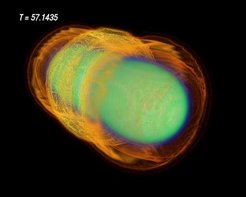Physicists contribute to cutting edge computing technology
Max Planck Institute for Gravitational Physics releases computational toolkit for high-performance simulations.
The Max Planck Institute for Gravitational Physics (Albert Einstein Institute - AEI) has announced the public beta release of the Cactus Computational Toolkit 4.0. The Toolkit is a result of years of research in computational science that won last years Heinz Billing prize, awarded for the advancement of scientific computing within the Max Planck Society. It pays tribute to the fact that high performance computing has become a vital tool for solving partial differential equations in many areas of physics and engineering. But the development of sophisticated programmes, that use computer power effectively, that work on various computer systems, and that keep up with the fast development of computer hardware, has become an insurmountable task for the individual, or small groups of scientists or engineers, driving them away from their initial aim to solve a science or engineering problem. Hence a more collaborative approach is needed. As Edward Seidel, head of the working group on "Numerical Relativity" at the AEI explains: " We need an enviroment, that allows the individual scientist with only working knowledge in standard programming languages like C or Fortran, to benefit from the most advanced computational techniques, to connect to programmes already developed by other colleagues somewhere else in the world, and to transform the code such that it runs on any chosen computer system most effectively."

More than a software package for solving partial differential equations, Cactus is a highly modular and collaborative environment. Individual scientists or engineers can plug their own computing application like a "thorn" into the "flesh" of the main Cactus Code. This allows them to call upon state of the art computer science modules imbedded in the "flesh" of the Cactus Code (like Adaptive Mesh Refinement, Advanced Parameter Parsers and Elliptic Solvers), to interact with applications, the "thorns" which other scientists have provided, and to parallelize their programme, so it runs on almost any computer system, not only on a personal laptop, but also on clusters of PC's or massively parallel supercomputers. Cactus employs advanced visualization tools, so that the evolution of specific parameters during the run can be visualized in two or three dimensional simulations. Interesting examples are the numerical simulations of neutron star collisions and the collapse of gravitational waves to a black hole, which have been performed this summer by AEI scientists in interaction with their collaborators in the USA.

Development of the Cactus Toolkit has been led by the AEI, in collaboration with researchers at the National Center for Supercomputing Applications (NCSA), USA, the University of the Balearic Islands in Spain, and Washington University, St. Louis, USA. It has been used and extended by about a dozen research groups in physics and computational science worldwide, including the Konrad-Zuse-Institut in Berlin, the Rechenzentrum-Garching, Argonne National Laboratory in the USA, and elsewhere. Ed Seidel points out that "Cactus benefits from a whole decade of research and advanced computing projects, as they have been demonstrated at supercomputing conferences since the early 1990's."Such a demonstration of the Cactus code, simulating the collision of two neutron stars, remotely using large parallel computers in San Diego, Berlin, and Garching connected by high speed transatlantic networks, and visualized live, was given at the Supercomputing '98 conference in Orlando, Florida. Only recently the National Science Foundation has awarded a 2.2million dollar grant to the US collaborators of Cactus, in order to extend the various capabilities of the Toolkit, for example to allow live simulations when the programme is running on a supercomputer somewhere in the world and to control the out-put and the run itself remotely over the network from far away.
Now the code is publicly accessible, complete with documentation and tutorials, and a tutorial workshop for using Cactus is being held this week at the NCSA at the University of Illinois in Champaign, IL, USA. The NCSA is one of the world's leading centers for computational science, and maintains very close collaborations with the AEI. The workshop is organized jointly by the AEI and the NCSA, and will be attended by over forty researchers from around the world. Future workshops, to be announced, will be held in Europe.













